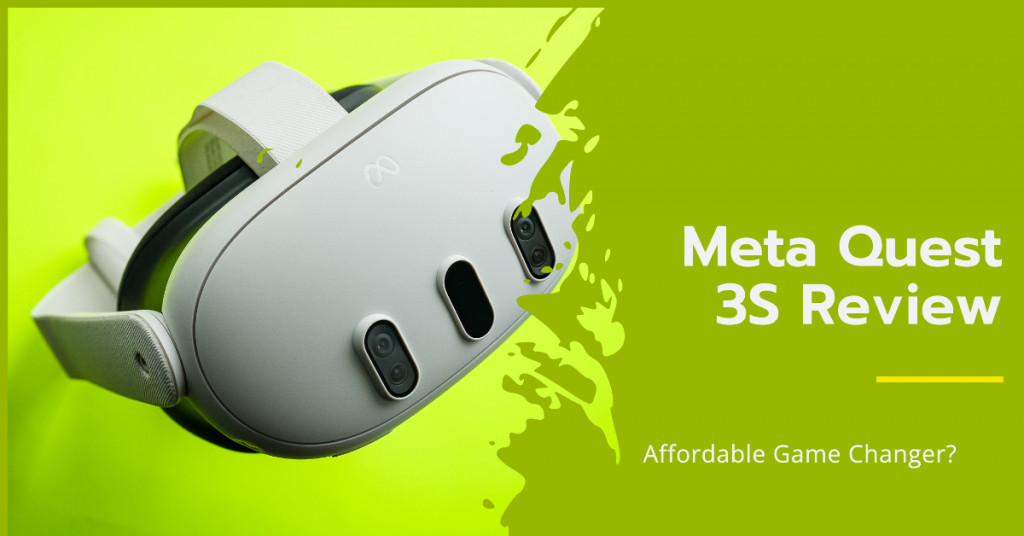The Meta Quest 3S has made quite an entrance into the VR scene, stirring mixed opinions. While it positions itself as a more affordable version of the Meta Quest 3, it inevitably raises questions: Does it cut too many corners to stay cheap, or does it still deliver an exceptional VR experience for its price?

After diving deep into this headset’s features, I’ve put together my detailed review of the Meta Quest 3S, so you can decide whether it’s worth the investment.
Key Takeaways:
| Feature | Meta Quest 3S Highlights |
|---|---|
| Price | Budget-friendly, starting at $300. |
| Design | Ergonomically designed, slightly bulkier than Quest 3. |
| Performance | Offers solid hand tracking but lacks eye tracking and depth projection. |
| Controllers | Same as Quest 3’s Touch Plus, but adds an Action Button for toggling modes. |
| Display and Resolution | Lower resolution and inferior lens clarity compared to Quest 3. |
| Compatibility | Compatible with most Quest 3 accessories, except the charging dock. |
| Notable Drawback | No 3.5mm headphone jack, lower room meshing quality. |
Design and Build Quality
The first thing you’ll notice about the Meta Quest 3S is its bulkier design compared to the sleeker Meta Quest 3. Despite this, I found it still fits comfortably on the head, even during long gaming or VR workout sessions.
It includes the breathable facial interface, a subtle yet noticeable upgrade for those who enjoy intense, sweat-inducing experiences like VR fitness. The design is thoughtfully made to accommodate users with glasses, which is great for accessibility.
However, the design does feel a bit dated due to the lack of premium finishes and the slightly heavier build. While Meta has clearly focused on keeping the cost down, this comes at the expense of a truly modern, sleek design.
Performance and Features
When it comes to performance, the Meta Quest 3S offers an impressive VR experience given its price. Meta has managed to pack in most of the capabilities you would expect from their more expensive models. Here’s where things get interesting though—while the Meta Quest 3S uses similar fresnel lenses as the Quest 2, the resolution is lower than the Quest 3, which makes a visible difference in clarity.
For casual VR users, the experience is perfectly fine. However, if you’ve used higher-end headsets like the Quest 3, you may notice the slight loss in lens sharpness.
Hand tracking is a huge plus, as the Meta Quest 3S includes two IR flood illuminators, making interactions smooth across different environments and lighting conditions. The lack of eye tracking and depth projector (a key feature in Quest 3 for enhanced mixed reality) does mean a slightly less immersive experience during MR (Mixed Reality) setup.
What I liked:
- Smooth hand-tracking even in low-light environments.
- Reliable performance during light gaming and productivity tasks.
What I didn’t like:
- No depth projection, so the quality of room-meshing during mixed reality isn’t as refined as the Quest 3.
Controllers and Usability
Let’s talk about controllers. The Meta Quest 3S includes the same Touch Plus controllers used in the Quest 3, but with a nice addition—a new Action Button that lets you quickly switch between passthrough mode (for mixed reality) and immersive VR. This feature replaces the double-tap gesture from previous models and provides a smoother, more seamless experience.
However, the Meta Quest 3S isn’t compatible with the Quest 3 charging dock because it lacks pogo pins. Meta has responded by offering a new Compact Charging Dock which includes wireless charging for the Touch Plus controllers and a USB-C cable for charging the headset.
Key Feature Breakdown:
- Action Button: Simplifies switching between VR and passthrough.
- Touch Plus controllers: Lightweight, comfortable, and responsive.
- Wireless charging: A nice upgrade for a budget model.
Software and App Ecosystem
One thing that makes the Meta Quest 3S a strong contender, despite its lower price point, is its compatibility with Meta’s massive ecosystem of VR apps and games. From high-octane gaming experiences like Batman: Arkham Shadow to mixed reality applications that blend productivity with fun, you’re getting access to the same ecosystem as you would with higher-end models. The multi-window setup lets you browse, play music, and run apps all while staying immersed in your virtual world.
Meta continues to provide dual open-ear speakers that offer decent audio performance. While it’s not as immersive as the Meta Quest Pro, the sound quality is impressive for a mid-tier headset.
Gaming Experience
If you’re primarily buying the Meta Quest 3S for gaming, it holds up well, though there are some compromises. The lower resolution becomes more noticeable during action-packed scenes or when you need sharp visuals for precise movements.
For example, when playing games like Superhot VR or Beat Saber, I found the visuals to be decent, but not as sharp as those on higher-end headsets.
In terms of controller performance, the Touch Plus controllers feel natural, and I didn’t experience any lag or disconnects during gameplay. Hand-tracking works remarkably well in VR games that support it, which adds another layer of immersion.
Price and Value
Here’s where the Meta Quest 3S truly shines—its price. Starting at $300, it’s one of the more affordable headsets on the market that still delivers a solid VR and mixed reality experience. Meta has clearly designed this headset to appeal to casual users or budget-conscious buyers who still want to dip their toes into VR gaming and productivity.
While the lower resolution and missing features like a 3.5mm headphone jack and charging dock compatibility might turn off some hardcore users, the Meta Quest 3S offers a lot for its price.
Pros and Cons
Pros:
- Affordable pricing for a mixed reality headset.
- Great hand-tracking and usability in low light.
- Smooth transition between VR and passthrough modes using the Action Button.
- Compatibility with most Quest 3 accessories.
Cons:
- Lower lens clarity and resolution than Meta Quest 3.
- No depth projector, which limits room-meshing accuracy.
- Not compatible with Quest 3 charging dock.
- The lack of a 3.5mm headphone jack might be frustrating for some users.
Conclusion
So, is the Meta Quest 3S a step backward in VR tech or an affordable game changer? The answer depends on what you’re looking for. If you’re a hardcore VR enthusiast or someone who demands cutting-edge features, then yes, the Quest 3S feels like a step backward in certain aspects.
But if you’re a casual user, or someone looking to get into VR without breaking the bank, the Meta Quest 3S delivers a solid experience at an unbeatable price.
Ultimately, the Meta Quest 3S is a fantastic entry-level or budget VR headset for those who want to experience Meta’s robust VR ecosystem without paying top dollar. It has its trade-offs, but for its price, it’s hard to beat.
Also Check:
- Samsung Galaxy Book Go: Decent Battery, Slim Design, But Performance Lags
- 4 Major Drawbacks of the Amazon Echo Pop 2024 I Didn’t Expect
- Amazon Echo 4th Gen Review: An Impressive Smart Speaker with Powerful Sound and Versatile…
- PS5 Pro Review – Is Sony’s New Console Worth the Upgrade?
- Amazon Fire Stick 4K vs Fire Stick 4K Max: Features, Performance, and Which One…
